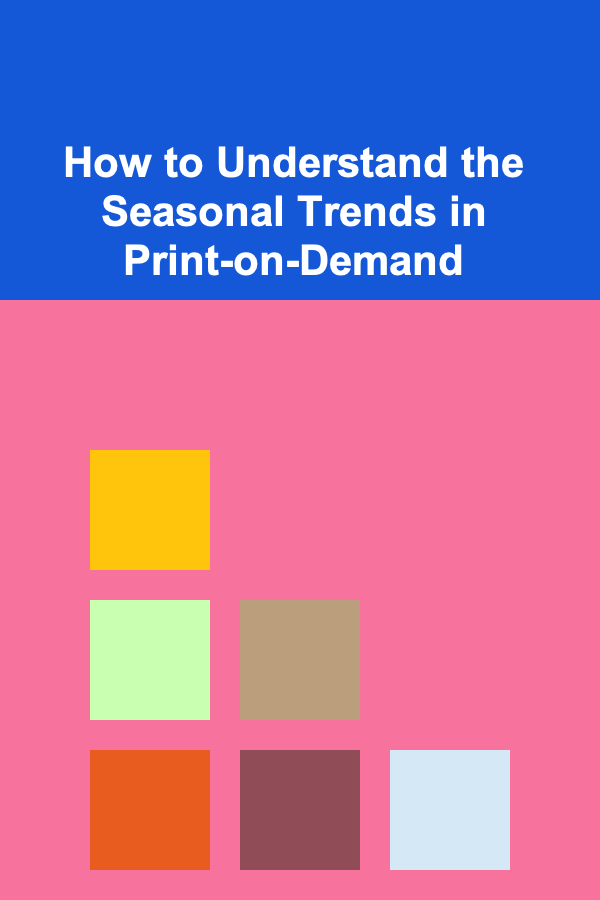
How to Understand the Seasonal Trends in Print-on-Demand
ebook include PDF & Audio bundle (Micro Guide)
$12.99$7.99
Limited Time Offer! Order within the next:

The print-on-demand (POD) business model has gained significant traction over the last decade, thanks to its low start-up costs, scalability, and the rise of e-commerce platforms like Shopify, Etsy, and Amazon. One of the most fascinating and essential aspects of running a POD business is understanding seasonal trends. These trends can significantly impact the types of products you sell, the designs you create, and the overall strategy you use to market your brand. In this article, we will delve into how you can understand and harness seasonal trends in the print-on-demand industry to increase sales, optimize product offerings, and improve your business strategy.
What Are Seasonal Trends in Print-on-Demand?
Seasonal trends in the POD industry refer to patterns in consumer behavior that shift according to the time of year. These trends often correspond to holidays, changes in weather, cultural events, and other cyclical events that influence purchasing behavior. For example, consumers may be more likely to buy T-shirts with Christmas-themed designs in December or custom mugs during the colder months. Understanding these patterns helps POD business owners make data-driven decisions and capitalize on the right opportunities.
Seasonal trends can vary from year to year, but they are often predictable, giving businesses an edge when they plan their inventory, marketing, and design strategies in advance.
The Importance of Seasonal Trends
Understanding seasonal trends in print-on-demand can lead to:
- Increased sales: By offering products that align with seasonal demand, you can increase the likelihood of a purchase.
- Effective marketing: Tailoring your marketing strategies to specific seasons or events allows you to craft more targeted and effective campaigns.
- Cost management: Knowing when demand will peak or drop can help businesses avoid overproduction or underproduction.
- Enhanced customer experience: By offering seasonal products, you can create a more personalized experience for customers, tapping into their emotions and needs.
Factors Affecting Seasonal Trends
Several factors influence seasonal trends, including:
- Weather Changes: Seasonal weather changes directly impact consumer needs. For instance, colder months may drive demand for sweatshirts, hoodies, and blankets, while summer months often see increased sales of T-shirts, tank tops, and hats.
- Holidays and Festivities: Key holidays like Christmas, Halloween, Valentine's Day, and Mother's Day can heavily influence product sales. Special occasions often lead to a spike in demand for themed merchandise.
- Cultural Events and Trends: Events like the Olympics, popular TV show premieres, or viral trends can shift the market for specific products. These events can create opportunities for designers to launch limited-edition items or themed collections.
- Consumer Behavior and Preferences: Consumer tastes change over time, and businesses need to track shifts in interest. Some years, eco-friendly products may be more in demand, while other years, vintage or nostalgic designs may dominate the market.
- Promotions and Discount Seasons: Black Friday, Cyber Monday, and back-to-school seasons are significant periods when consumers actively seek deals, often boosting demand for products across the board.
Key Seasonal Trends in Print-on-Demand
To successfully navigate the seasonal trends in print-on-demand, it's crucial to identify the key periods when demand for certain products surges. Below are some of the most prominent seasonal trends you should consider:
1. Winter (November to February)
During the winter months, people tend to focus on staying warm, celebrating holidays, and preparing for the new year. This season sees high sales of the following products:
- Apparel: Hoodies, sweatshirts, and long-sleeve shirts are popular as people layer up for warmth.
- Winter Accessories: Beanies, scarves, and gloves are common seasonal products.
- Holiday Gifts: Customizable items like mugs, T-shirts, and calendars are popular holiday gifts, particularly for Christmas and New Year.
- Home Décor: Items such as custom blankets, throw pillows, and holiday-themed wall art tend to sell well during this season.
Marketing Tip: Launch holiday-themed campaigns in late October or early November to capture pre-holiday shopping. Offer limited-edition designs with seasonal motifs like snowflakes, Christmas trees, and New Year's countdowns.
2. Spring (March to May)
Spring represents renewal and growth. People are gearing up for warmer weather, which leads to shifts in the types of products that are in demand. Some popular POD items in spring include:
- Light Apparel: T-shirts, tank tops, and light jackets are commonly worn as the weather warms up.
- Outdoor Products: As people begin spending more time outdoors, items like water bottles, hats, and sunglasses become more popular.
- Floral and Pastel Designs: Spring is often associated with flowers and bright pastel colors, making floral-themed apparel and décor items a hit.
- Mother's Day Products: Customizable gifts for Mother's Day (cards, mugs, and clothing) see significant demand during April and May.
Marketing Tip: Focus on creating products with nature, flowers, and soft colors. Highlight springtime themes in your campaigns and offer discounts or bundles for Mother's Day.
3. Summer (June to August)
Summer is one of the most active seasons in the POD industry, with people enjoying vacations, outdoor activities, and festivals. During this season, you can expect high demand for:
- Light and Breathable Clothing: Tank tops, summer dresses, shorts, and swimsuits are in demand during the hot months.
- Beach and Pool Accessories: Items like beach towels, flip-flops, and tote bags are popular during summer.
- Vacation Gear: Travel accessories such as personalized luggage tags, travel mugs, and custom beach bags sell well in this season.
- Summer Events: Festivals, weddings, and outdoor concerts drive demand for themed apparel and accessories.
Marketing Tip: Leverage the excitement of summer travel and events. Use social media campaigns to highlight summer adventures and offer discounts on travel-related merchandise.
4. Fall (September to October)
Fall brings cooler temperatures and a focus on preparing for the holidays. Some popular print-on-demand products for fall include:
- Layered Apparel: Fall often means the return of sweatshirts, jackets, and long-sleeve shirts.
- Halloween Products: Custom T-shirts, hoodies, and home décor featuring Halloween-themed designs are big sellers during this time.
- Thanksgiving Gifts: Personalized items like T-shirts, mugs, and aprons are often given as gifts during the Thanksgiving season.
Marketing Tip: Capitalize on Halloween and Thanksgiving with unique, limited-time designs. Use storytelling and nostalgia in your product descriptions to appeal to customers' emotional connections with fall.
How to Analyze and Predict Seasonal Trends
To stay ahead of seasonal trends, it's crucial to analyze data and predict what will be in demand next. Here are several ways you can track and understand seasonal trends:
1. Historical Data: Look at sales trends from previous years to identify patterns in consumer purchasing behavior. Platforms like Etsy and Shopify provide insights into the most popular product categories and trends by season.
2. Google Trends: Use Google Trends to track what people are searching for during specific months or seasons. This tool can help you identify emerging trends and shifts in consumer interest.
3. Social Media: Social platforms like Instagram, Pinterest, and TikTok are great places to spot rising trends in fashion, art, and culture. Monitor hashtags and influencers to see what products are gaining traction.
4. Competitor Analysis: Keep an eye on what your competitors are offering. If they start launching seasonal collections ahead of time, it may indicate that a certain trend is about to peak.
5. Customer Feedback: Listening to your customers can provide invaluable insight into their seasonal preferences. Ask them directly through surveys or track reviews and comments on your store to adjust your offerings.
Tips for Maximizing Seasonal Trends in POD
- Plan Ahead: Start preparing for key seasons several months in advance to ensure you have the right products and designs ready.
- Use Limited Editions: Create exclusive seasonal products that are available for a short time to encourage urgency in customers.
- Cross-Sell Related Products: Offer related products in your marketing campaigns. For example, during the winter, you could bundle a hoodie with a mug or a blanket with socks.
- Leverage Seasonal Marketing: Run targeted campaigns on social media, email, and search engines tailored to the season. Utilize SEO strategies to align with keywords related to specific seasonal events or holidays.
Conclusion
Understanding seasonal trends in print-on-demand is essential for maximizing your sales and growing your business. By recognizing the cyclical nature of consumer behavior and leveraging the right marketing, design, and inventory strategies, you can stay ahead of the competition and make the most out of every season. Use data, creativity, and careful planning to tap into the power of seasonal demand and create products that resonate with your audience year-round.
Reading More From Our Other Websites
- [Home Space Saving 101] How to Optimize Your Laundry Room: Smart Mudroom Organization Ideas Even Without a Mudroom
- [Personal Care Tips 101] How to Select an Antibacterial Mouthwash for Oral Infections
- [Organization Tip 101] How to Organize Your Recipe Books by Cuisine
- [Home Pet Care 101] How to Create a Cat-Friendly Vertical Space on a Budget
- [Organization Tip 101] How to Develop a Habit of Daily Decluttering
- [Personal Care Tips 101] How to Choose a Body Butter with the Best Moisturizing Properties
- [Organization Tip 101] Why You Should Create a Command Center for Family Schedules
- [Home Space Saving 101] How to Maximize Closet Storage Without Overcrowding
- [Home Maintenance 101] How to Keep Your Home's Garage Organized and Maintained
- [Personal Investment 101] Top Ways to Make Money Using Deep Learning Techniques

How to Add Value to Your Home Through Simple Staging Changes
Read More
How to Invest for Beginners: A Step-by-Step Guide
Read More
How To Practice Your Speech for Perfection
Read More
Slow Travel vs. Fast Travel: A Deep Dive into Travel Styles
Read More
How to Create a Fitness Planner for Beginners
Read More
10 Tips for Planning a Scuba Diving Vacation on a Budget
Read MoreOther Products

How to Add Value to Your Home Through Simple Staging Changes
Read More
How to Invest for Beginners: A Step-by-Step Guide
Read More
How To Practice Your Speech for Perfection
Read More
Slow Travel vs. Fast Travel: A Deep Dive into Travel Styles
Read More
How to Create a Fitness Planner for Beginners
Read More